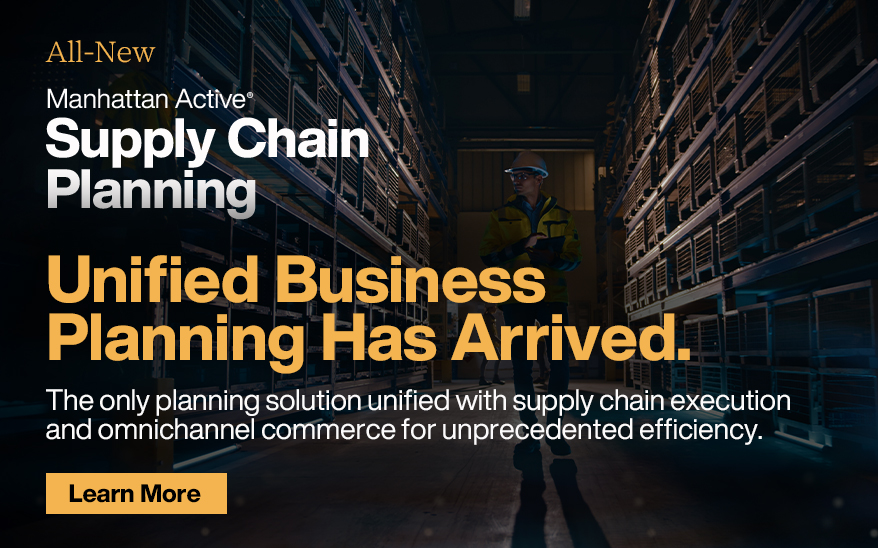
Bridging the Gap Between Supply Chain Planning and Execution
In today's fast-paced market, a seamless connection between supply chain planning (SCP) and supply chain execution (SCE) is no longer optional. It's essential. Don't let outdated, siloed systems hold your business back. Read on to learn how a unified approach to your supply chain can revolutionize your business.
Bridging the Gap Between Supply Chain Planning and Execution
The Current State: Siloed Systems and Operations are Everywhere
We are operating in the age of instant expectations, with today’s consumers sitting at the center of their digital universe, expecting instant purchases—from cookies to TVs—delivered right to their doorsteps. Modern supply chain systems must keep pace, ensuring inventory is available to customers whenever and wherever they need it. Even the best omnichannel and supply chain execution systems can't help if the inventory is too little, too late, or in the wrong place.
Historically, there has been a disconnect between supply chain planning and execution processes and applications. As a result, companies tend to plan, optimize and execute their inventory, labor, transportation, and warehousing operations separately, in a siloed manner.
How prevalent are disconnected supply chain planning and execution systems? What problems are caused by poorly integrated or siloed supply chain planning and execution processes? What are enterprises' most significant obstacles in bridging the gap between supply chain planning and execution processes? To explore answers to these and other questions, supply chain and logistics industry expert Adrian Gonzalez, from Adelante SCM, surveyed members of the Indago research community and Manhattan’s supply chain planning product council for their insights, perspectives and preferences.
The survey, conducted with supply chain and logistics executives across manufacturing, retail, and distribution industries, revealed that only a relatively small number of companies plan, optimize and execute their inventory, labor, transportation, and warehousing operations in an integrated/synchronized way. Most either plan, optimize and execute these functions in a siloed manner, or they plan/optimize some functions together and others separately.
The Current State.
Consequences of Siloed Supply Chain Operations
The disparate systems for supply chain planning (SCP) and supply chain execution (SCE) have significant consequences for enterprises operating in a global supply chain ecosystem. These issues hinder companies from meeting customer expectations of convenience and instant gratification.
Siloed operations make it difficult for supply chains to adapt and evolve—a necessity for modern enterprises. Adelante SCM’s survey respondents identified various issues that can lead to inefficiencies, lack of visibility, and slow response times to market changes.
Reduced flexibility/responsiveness to change
Increase in transportation costs
Poor labor utilization
Reduced productivity/efficiency
Lack of real-time visibility
Unification, Not Integration, Will Overcome Challenges
When asked about the most significant challenges they faced in bridging the gap between SCP and SCE, survey respondents identified a lack of cross-functional metrics, use of manual processes, and resistance to change as the top three factors. However, 4 out of 10 respondents identified integrating many different systems as a critical obstacle.
Top Five Obstacles to Bridging the Gap
Lack of cross-functional metrics
Reliance on Excel or manual processed
Change management
Integrating many different systems
Siloed data
Many current supply chain planning systems were designed for a store-centric world, where slow, disconnected processes like sales and operations planning (S&OP) and sales and operations execution (S&OE) sufficed. However, with the rise of ecommerce and real-time consumer demand, these legacy systems struggle to keep pace. Therefore, over the last five years, supply chain leaders have advocated for the closer integration of disparate execution systems like WMS, TMS, OMS, LMS, etc. – as well as planning tools – in the hopes of ultimately creating a supply chain that is agile, customer-focused and capable of leveraging real-time data to adjust rapidly to fluctuations in supply and demand.
Integration of separate applications, no matter how seamless, still creates barriers to the flow of information across a supply chain. Stitching together WMS, TMS, OMS, and planning tools often results in complex interfaces and data inconsistencies. In other words, integration may provide connectivity, but it doesn't guarantee seamless collaboration or real-time data synchronization.
As one of the executives in the surveys explained:
“Bridging the gap between planning and execution starts with the top of supply chain leadership. Planning and execution need to be aware of what the other is doing and make sure that planning and forecasting is realistic… A single architecture or platform would be ideal; however, I have seen trouble ‘translating’ the same data between different groups of the organization. For example, Sales focuses on revenue numbers, Planning might focus on purchased units, Logistics might focus on cartons and containers, and all these numbers need to be planned and forecasted in the same manner otherwise each department might take liberties or adjust the numbers from the top to translate it into what matters most for them.”
Today’s supply chain must undergo a paradigm shift towards creating a unified supply chain that breaks down barriers between planning and execution.
Unifying supply chain operations from planning and execution allows companies to operate with a shared vision and common goals. A unified, composable platform is designed from the ground up on a cloud-native architecture to ensure interoperability, consistent data models, and shared user interfaces, which are vital for:
- Bi-Directional Communication: Ensuring that changes in one area automatically trigger updates in others.
- Simplified IT Management: Reducing the complexity associated with managing multiple integrated systems.
- User Adoption: Providing a consistent user experience across all functions encourages user engagement and reduces training requirements.
The ideal of “a single architecture or platform” is now a reality.
Unified Supply Chain Planning Means Being Able to Adjust on the Fly
“Having a better understanding of future order demand and pending workload to optimize resources more efficiently would be helpful. If applications are able to better predict future workload demand and intelligently plan or assign tasks to different groups or pools, we should be able to have better execution. It would be even better if recommendations or changes could happen automatically based on shifting demand needs. There is configuration that supports this idea, but it is configured with defined parameters rather than being able to adjust on the fly.”
Adjusting demand and workload, not just on pre-defined and inherently limiting parameters, but on real-time insights into the supply chain network is now possible. A unified approach allows seamless integration of external trend data with internal historical patterns and enhances decision-making with AI-driven computational intelligence that optimizes your supply chain planning. Outside-in and Inside-out data incorporates real-time market intelligence with your own operational data, creating a crystal-clear, holistic view of your supply chain.
Unified business planning with Manhattan Active SCP allows for agile alignment – and continuous realignment – of inventories, labor, transportation, and facilities within a single shared plan. This ensures cohesive and strategic optimization of resources and systems towards common goals and KPIs, avoiding conflicting actions and enhancing overall efficiency.
Unified Business Planning Has Arrived
Manhattan Active® Supply Chain Planning (SCP) unites with Manhattan Active Omni and Manhattan Active Supply Chain to create the first truly unified business planning solution on a microservices API, cloud-native platform. Manhattan Active SCP marks a new era in strategic enterprise planning by continuously optimizing inventory, orders, labor, distribution, and transportation to a single plan.
Many of the survey respondents believe that having supply chain planning and execution applications on a single platform/architecture can help, as these comments highlight:
“The technology available is not properly used to allow synchronization and having applications on a single platform would help.”
“Moving away from multiple platforms/systems to be on one platform/architecture is a goal.”
“Single platform means access to the same information and should provide better results.”
“I do believe having visibility to planning and execution on a single platform could help.”
Consider the case of a multi-channel, specialty retailer of hard surface flooring. The company frequently tests new flooring designs in various regions. When one of its trials is successful, the organization must align resources across the supply chain to rapidly meet demand. Meanwhile, the company’s shoppers are impatient. When they have a home improvement project that needs to be done, the flooring design they want must be available now. With Manhattan Active SCP, this retailer no longer has to adjust its inventory plan manually. Instead, the platform itself is the plan. By flipping a switch, they can seamlessly shift from trial mode to complete replenishment, with labor, transportation, and inventory all adapting automatically to the new demand.
This hypothetical yet very realistic scenario underscores the power of unifying SCP and SCE, where all functions within the supply chain are aligned and respond in real-time to changes in demand.
The Bottom Line
In a rapidly changing business landscape, the ability to respond quickly and efficiently to market demands is a significant competitive advantage. The findings from the Adelante SCM/Indago survey make it clear: companies that continue to operate with silos between supply chain planning and execution risk falling behind in a world that demands agility and responsiveness. To bridge this gap, organizations must go beyond integrating different applications. They must adopt both advanced technology solutions and implement cultural and organizational changes that encourage cross-functional collaboration.
By embracing a unified, composable platform architecture with continuous, bi-directional coordination, businesses can navigate the realities of today’s consumers and drive sustainable growth.
With the right mix of technology and strategy, the once-fragmented supply chain can evolve into a unified, agile system capable of meeting modern market demands.
As one survey respondent aptly put it:
"Ultimately everyone must share the same goals for success, and the metrics for measuring them. When you realize this can only be achieved through the same resource pool, you will have the ideal situation."
This research report is based on the findings and analysis from a July 2024 Adelante SCM-led Indago survey of 54 supply chain and logistics executives from manufacturing, retail, distribution, and third-party logistics companies, along with insights from Manhattan supply chain planning subject matter experts.
About Adrian Gonzalez, Adelante SCM
Adrian Gonzalez, founder and president of Adelante SCM, is a trusted advisor and leading industry analyst with more than 24 years of research experience in transportation management, logistics outsourcing, global trade management, social media, and other supply chain and logistics topics. In addition to launching Talking Logistics, Adrian established Adelante SCM, a peer-to-peer learning and networking community for supply chain and logistics executives and young professionals. He is also the founder of Indago, a market research service that brings together a community of supply chain and logistics practitioners who share practical knowledge and advice with each other while giving back to charitable causes. Gonzalez held various leadership positions at ARC Advisory Group, Motorola, Polaroid, and Clare. He is also a member of the Council of Supply Chain Management Professionals and is a LinkedIn influencer.




